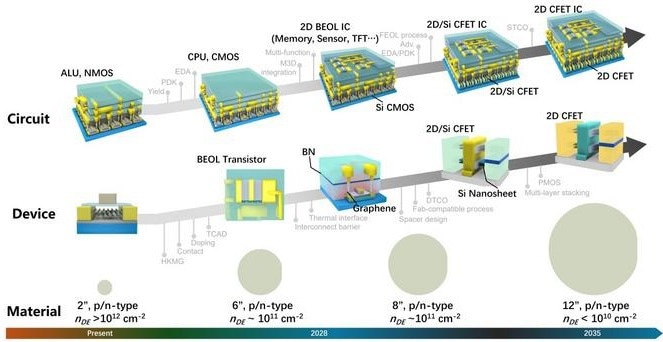Reviewed by Lexie CornerJun 10 2024
A recent review paper from the “Shuang-Qing Forum” thoroughly analyzes the accomplishments and strategic plan for two-dimensional (2D) materials, marking a significant step forward for the semiconductor industry. This study was published in the journal Science China Information Sciences.
 Roadmap for the future development of 2D information materials layout planning. Image Credit: Science China Press
Roadmap for the future development of 2D information materials layout planning. Image Credit: Science China Press
The progression of 2D materials from basic research to industrial development is described in this collaborative effort by eminent Chinese experts, emphasizing the vital role that specialized tools, artificial intelligence, and industry-academia cooperation play in propelling this technological revolution.
A New Era in Semiconductor Miniaturization
The semiconductor sector has been instrumental in propelling technological progress over the last seven decades, bringing about constant downsizing and performance enhancements. In the search for the next generation of transistors based on atomically thin channels, 2D materials like Transition Metal Dichalcogenides (TMDs) stand out as promising options. The pursuit of Moore's Law has led to the research of innovative materials and geometries.
Strategic Roadmap for 2D Materials
To fulfill industrial standards for 2D materials, the review article highlights the necessity of specialized technology and techniques. It highlights the significance of material growth, characterization, and circuit design, paving the way for industry-academia cooperation to spearhead 2D material research in the upcoming ten years. The roadmap's primary sections are as follows:
- Materials: Scaling Up with Precision
The successful scaling up of production is critical to the future of 2D semiconductor materials. The industry has made progress with 2-inch n-type single-crystal wafers, but material flaws remain a problem. Future developments will primarily focus on two areas: producing larger single crystals with perfect defect control and p/n-type materials that behave similarly to silicon.
- Characterization: The Indispensable Role of AI
Sophisticated characterization techniques that have achieved sub-atomic resolution levels are meeting the needs of 2D materials. Standardizing and refining assessment criteria requires the integration of AI techniques to ensure accuracy and efficiency in the analysis of experimental metadata.
- Electronic Devices: Synergy of BEOL and FEOL
2D semiconductor devices are getting closer to silicon-based devices in terms of performance metrics. Subsequent developments will concentrate on fundamental technologies, such as controlled doping and HKMG integration, to maximize space, power consumption, and performance.
- Thermal Management and Interconnects: Overcoming RC Delays
Reducing RC delays and managing heat effectively is essential for semiconductor devices. Performance and reliability are expected to be improved by using materials with a lower dielectric constant and integrating 2D materials like graphene and hexagonal boron nitride (h-BN).
- Integrated Circuits: Embracing 3D Integration
The future of integrated circuits (ICs) built on 2D semiconductors is evolving towards 3D integration. By utilizing the benefits of 2D semiconductors for monolithic 3D heterogeneous integration, this shift will improve the functionality and energy efficiency of individual chips.
- Optoelectronic Integration: The Path to High-Throughput Technologies
High-throughput information technologies are about to take a significant turn in the direction of optoelectronic integration. This future trajectory hinges on the synthesis of large-scale, high-quality single crystals, as well as the development of multifunctional integrated devices.
Journal Reference:
Qiu, H., et al. (2024) Two-dimensional materials for future information technology: status and prospects. Science China Information Sciences. doi.org/10.1007/s11432-024-4033-8